Current Development in Accounting Thought: Analysis Report
VerifiedAdded on 2023/01/13
|14
|3289
|57
Report
AI Summary
This report delves into the evolution of accounting thought, beginning with a critique of historical cost accounting (HCA) and its limitations, particularly during periods of rising prices. It explores the issues of irrelevance, distortion of financial results, and the 'additivity problem' inherent in HCA. The report then introduces current cost accounting (CCA) as an alternative, highlighting its advantages in providing more realistic asset valuations and considering inflation. The report then examines the role and purpose of the conceptual framework in accounting, analyzing its objectives, benefits, and potential criticisms, including its role in maintaining the accounting profession's standing. The report concludes by discussing measurement issues within the conceptual framework, focusing on the principles for determining the appropriate methods for measurement and how the framework addresses uncertainties in asset and liability valuation.
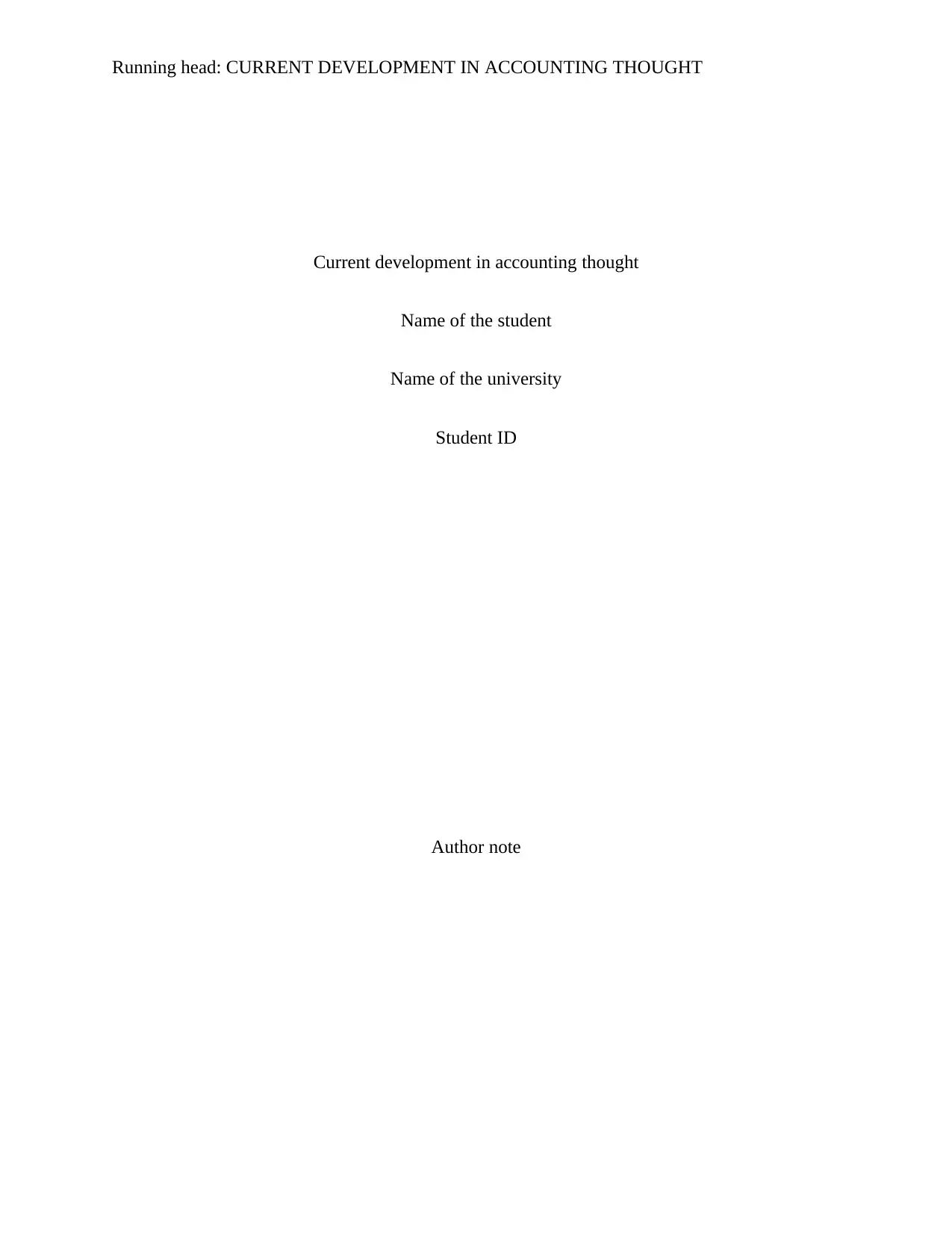
Running head: CURRENT DEVELOPMENT IN ACCOUNTING THOUGHT
Current development in accounting thought
Name of the student
Name of the university
Student ID
Author note
Current development in accounting thought
Name of the student
Name of the university
Student ID
Author note
Paraphrase This Document
Need a fresh take? Get an instant paraphrase of this document with our AI Paraphraser
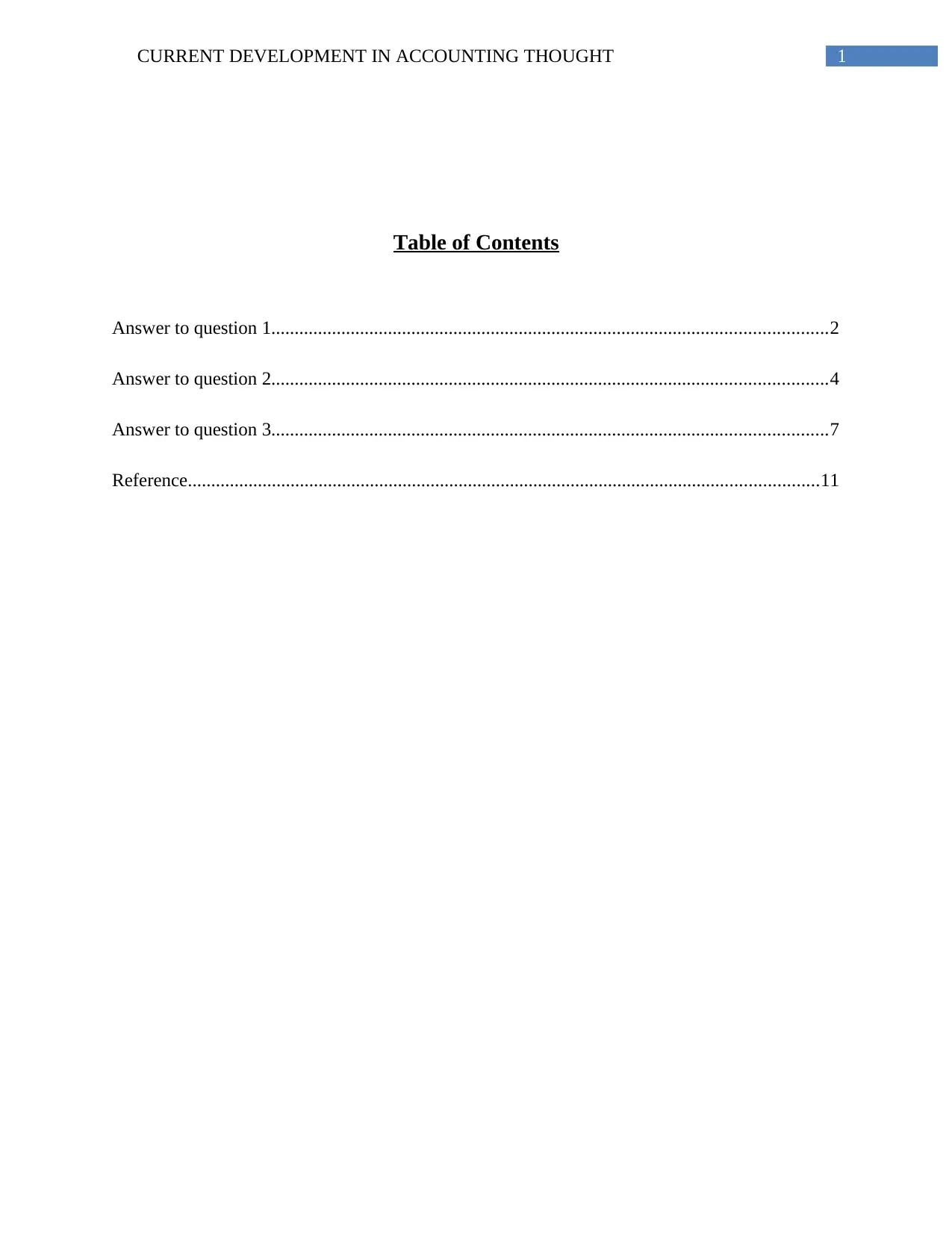
1CURRENT DEVELOPMENT IN ACCOUNTING THOUGHT
Table of Contents
Answer to question 1.......................................................................................................................2
Answer to question 2.......................................................................................................................4
Answer to question 3.......................................................................................................................7
Reference.......................................................................................................................................11
Table of Contents
Answer to question 1.......................................................................................................................2
Answer to question 2.......................................................................................................................4
Answer to question 3.......................................................................................................................7
Reference.......................................................................................................................................11
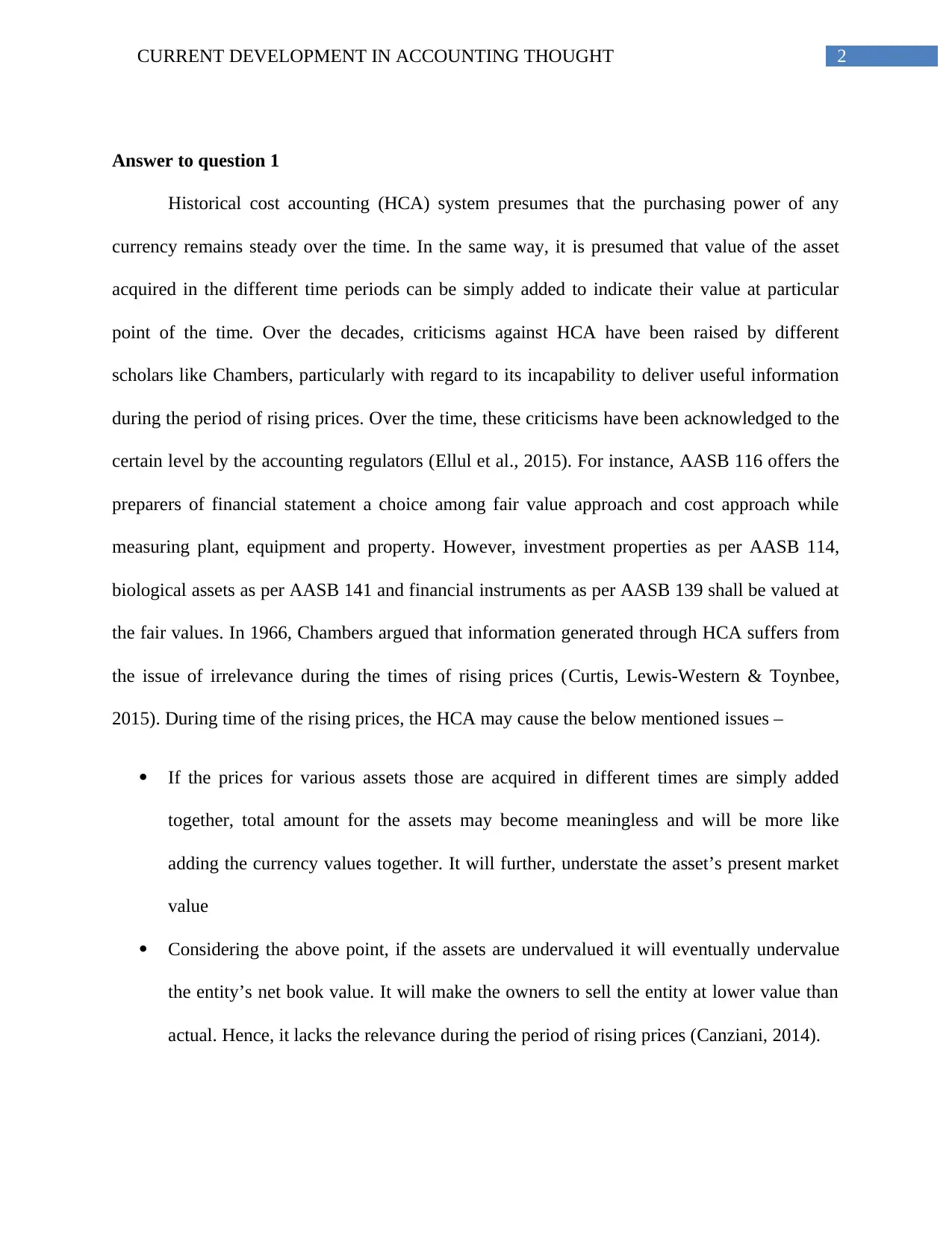
2CURRENT DEVELOPMENT IN ACCOUNTING THOUGHT
Answer to question 1
Historical cost accounting (HCA) system presumes that the purchasing power of any
currency remains steady over the time. In the same way, it is presumed that value of the asset
acquired in the different time periods can be simply added to indicate their value at particular
point of the time. Over the decades, criticisms against HCA have been raised by different
scholars like Chambers, particularly with regard to its incapability to deliver useful information
during the period of rising prices. Over the time, these criticisms have been acknowledged to the
certain level by the accounting regulators (Ellul et al., 2015). For instance, AASB 116 offers the
preparers of financial statement a choice among fair value approach and cost approach while
measuring plant, equipment and property. However, investment properties as per AASB 114,
biological assets as per AASB 141 and financial instruments as per AASB 139 shall be valued at
the fair values. In 1966, Chambers argued that information generated through HCA suffers from
the issue of irrelevance during the times of rising prices (Curtis, Lewis-Western & Toynbee,
2015). During time of the rising prices, the HCA may cause the below mentioned issues –
If the prices for various assets those are acquired in different times are simply added
together, total amount for the assets may become meaningless and will be more like
adding the currency values together. It will further, understate the asset’s present market
value
Considering the above point, if the assets are undervalued it will eventually undervalue
the entity’s net book value. It will make the owners to sell the entity at lower value than
actual. Hence, it lacks the relevance during the period of rising prices (Canziani, 2014).
Answer to question 1
Historical cost accounting (HCA) system presumes that the purchasing power of any
currency remains steady over the time. In the same way, it is presumed that value of the asset
acquired in the different time periods can be simply added to indicate their value at particular
point of the time. Over the decades, criticisms against HCA have been raised by different
scholars like Chambers, particularly with regard to its incapability to deliver useful information
during the period of rising prices. Over the time, these criticisms have been acknowledged to the
certain level by the accounting regulators (Ellul et al., 2015). For instance, AASB 116 offers the
preparers of financial statement a choice among fair value approach and cost approach while
measuring plant, equipment and property. However, investment properties as per AASB 114,
biological assets as per AASB 141 and financial instruments as per AASB 139 shall be valued at
the fair values. In 1966, Chambers argued that information generated through HCA suffers from
the issue of irrelevance during the times of rising prices (Curtis, Lewis-Western & Toynbee,
2015). During time of the rising prices, the HCA may cause the below mentioned issues –
If the prices for various assets those are acquired in different times are simply added
together, total amount for the assets may become meaningless and will be more like
adding the currency values together. It will further, understate the asset’s present market
value
Considering the above point, if the assets are undervalued it will eventually undervalue
the entity’s net book value. It will make the owners to sell the entity at lower value than
actual. Hence, it lacks the relevance during the period of rising prices (Canziani, 2014).
⊘ This is a preview!⊘
Do you want full access?
Subscribe today to unlock all pages.

Trusted by 1+ million students worldwide

3CURRENT DEVELOPMENT IN ACCOUNTING THOUGHT
Under historical cost method the COGS and depreciation are based on the historical cost
that means the profits will be overstated during the period of rising prices. However, the
dividends can be paid out of the profits which in turn may erode the firm’s actual
operating efficiency. This is because too much will be distributed to owners and
insufficient amount will be retained for replacing the assets whose replacement cost
might have increased.
Under the historical cost method, operating result of current year will be distorted as it
will include the income holding gain for the current year that may have generated for
number of years (Canziani, 2014).
It relies upon the arbitrary cost allocation that have little correspondence with the actual
changes in the value of the asset
Information those are generated through the historical cost approach suffers from
“additivity problem” that is adding the values of assets together acquired in different
times makes little sense (Li, 2015).
Alternative to the historical cist that may provide the information of greater relevance to
the accounting users is Current cost accounting
Current cost accounting (CCA) provides more realistic values through valuing the assets
at the current buying price in the market. It considers the inflation and time value of the money.
CCA is more complex as compared to the HCA and created controversies regarding the
appropriate adjustments. Unlike the historical cost approach in CCA no need is there for the
assumption of inventory cost flow like weighted average and last-in-first-out. Further, the
business profit under CCA represents the way in which the entity gained the increase in resource
cost in financial terms that is not considered under historical approach (Kirkman, 2014). Holding
Under historical cost method the COGS and depreciation are based on the historical cost
that means the profits will be overstated during the period of rising prices. However, the
dividends can be paid out of the profits which in turn may erode the firm’s actual
operating efficiency. This is because too much will be distributed to owners and
insufficient amount will be retained for replacing the assets whose replacement cost
might have increased.
Under the historical cost method, operating result of current year will be distorted as it
will include the income holding gain for the current year that may have generated for
number of years (Canziani, 2014).
It relies upon the arbitrary cost allocation that have little correspondence with the actual
changes in the value of the asset
Information those are generated through the historical cost approach suffers from
“additivity problem” that is adding the values of assets together acquired in different
times makes little sense (Li, 2015).
Alternative to the historical cist that may provide the information of greater relevance to
the accounting users is Current cost accounting
Current cost accounting (CCA) provides more realistic values through valuing the assets
at the current buying price in the market. It considers the inflation and time value of the money.
CCA is more complex as compared to the HCA and created controversies regarding the
appropriate adjustments. Unlike the historical cost approach in CCA no need is there for the
assumption of inventory cost flow like weighted average and last-in-first-out. Further, the
business profit under CCA represents the way in which the entity gained the increase in resource
cost in financial terms that is not considered under historical approach (Kirkman, 2014). Holding
Paraphrase This Document
Need a fresh take? Get an instant paraphrase of this document with our AI Paraphraser
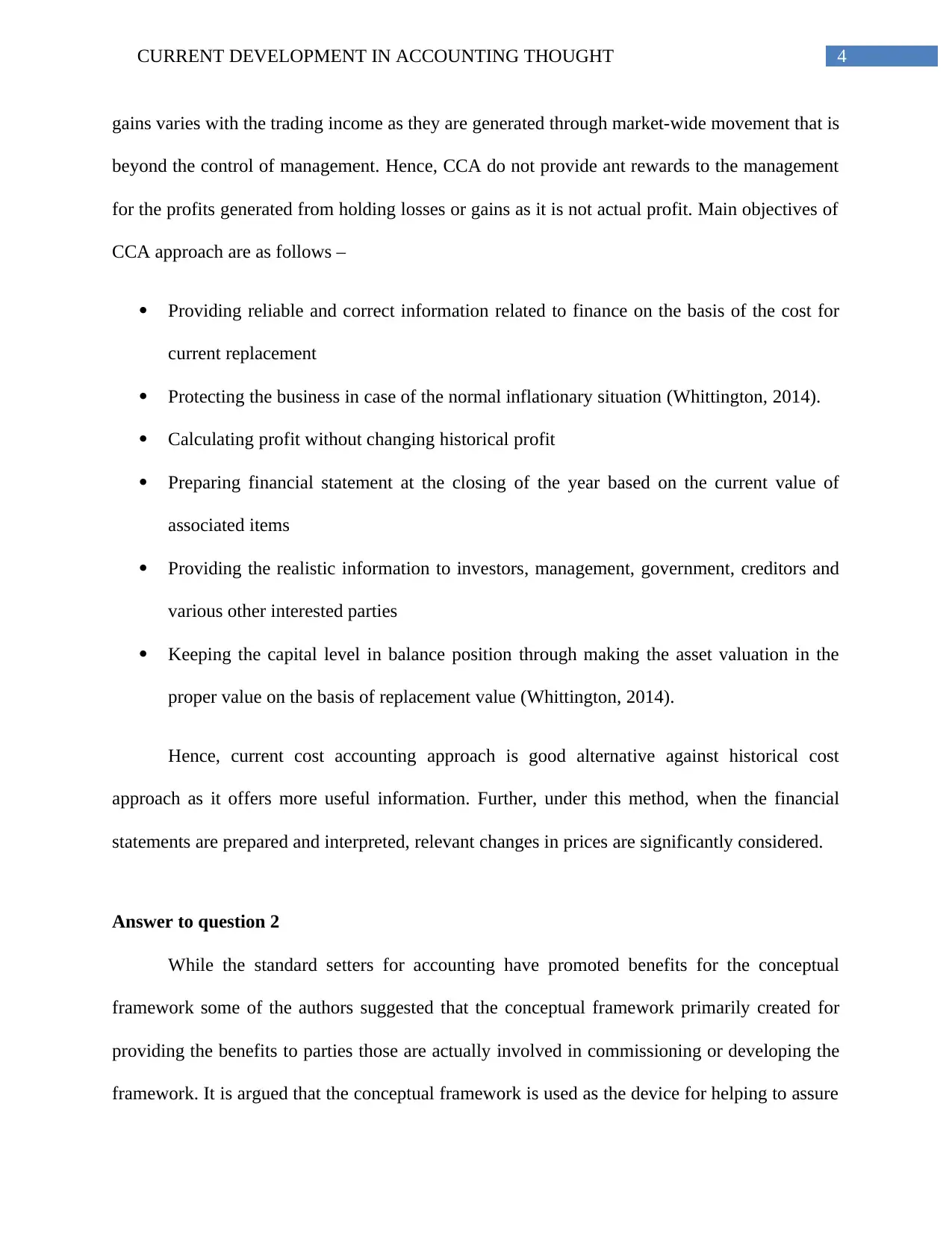
4CURRENT DEVELOPMENT IN ACCOUNTING THOUGHT
gains varies with the trading income as they are generated through market-wide movement that is
beyond the control of management. Hence, CCA do not provide ant rewards to the management
for the profits generated from holding losses or gains as it is not actual profit. Main objectives of
CCA approach are as follows –
Providing reliable and correct information related to finance on the basis of the cost for
current replacement
Protecting the business in case of the normal inflationary situation (Whittington, 2014).
Calculating profit without changing historical profit
Preparing financial statement at the closing of the year based on the current value of
associated items
Providing the realistic information to investors, management, government, creditors and
various other interested parties
Keeping the capital level in balance position through making the asset valuation in the
proper value on the basis of replacement value (Whittington, 2014).
Hence, current cost accounting approach is good alternative against historical cost
approach as it offers more useful information. Further, under this method, when the financial
statements are prepared and interpreted, relevant changes in prices are significantly considered.
Answer to question 2
While the standard setters for accounting have promoted benefits for the conceptual
framework some of the authors suggested that the conceptual framework primarily created for
providing the benefits to parties those are actually involved in commissioning or developing the
framework. It is argued that the conceptual framework is used as the device for helping to assure
gains varies with the trading income as they are generated through market-wide movement that is
beyond the control of management. Hence, CCA do not provide ant rewards to the management
for the profits generated from holding losses or gains as it is not actual profit. Main objectives of
CCA approach are as follows –
Providing reliable and correct information related to finance on the basis of the cost for
current replacement
Protecting the business in case of the normal inflationary situation (Whittington, 2014).
Calculating profit without changing historical profit
Preparing financial statement at the closing of the year based on the current value of
associated items
Providing the realistic information to investors, management, government, creditors and
various other interested parties
Keeping the capital level in balance position through making the asset valuation in the
proper value on the basis of replacement value (Whittington, 2014).
Hence, current cost accounting approach is good alternative against historical cost
approach as it offers more useful information. Further, under this method, when the financial
statements are prepared and interpreted, relevant changes in prices are significantly considered.
Answer to question 2
While the standard setters for accounting have promoted benefits for the conceptual
framework some of the authors suggested that the conceptual framework primarily created for
providing the benefits to parties those are actually involved in commissioning or developing the
framework. It is argued that the conceptual framework is used as the device for helping to assure
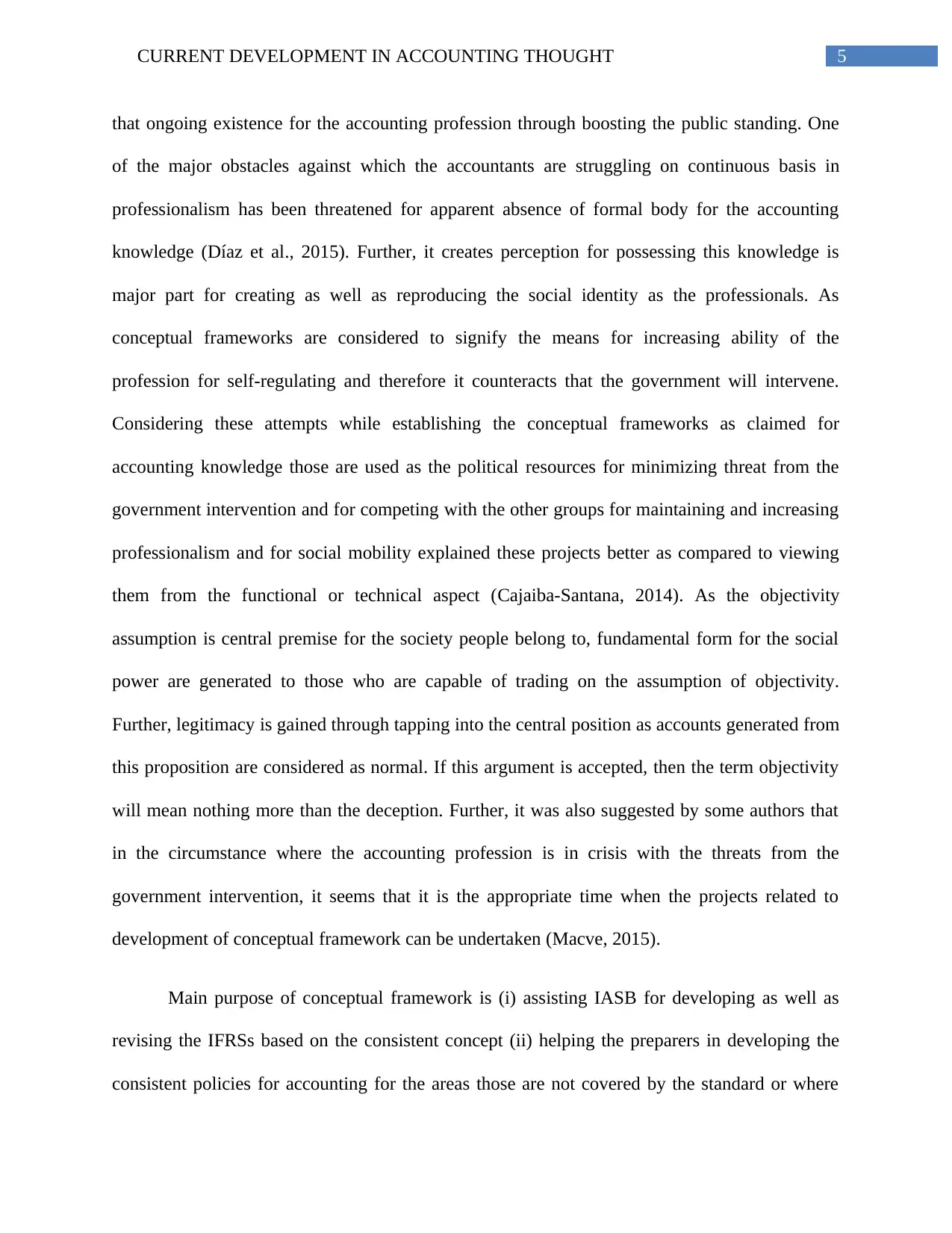
5CURRENT DEVELOPMENT IN ACCOUNTING THOUGHT
that ongoing existence for the accounting profession through boosting the public standing. One
of the major obstacles against which the accountants are struggling on continuous basis in
professionalism has been threatened for apparent absence of formal body for the accounting
knowledge (Díaz et al., 2015). Further, it creates perception for possessing this knowledge is
major part for creating as well as reproducing the social identity as the professionals. As
conceptual frameworks are considered to signify the means for increasing ability of the
profession for self-regulating and therefore it counteracts that the government will intervene.
Considering these attempts while establishing the conceptual frameworks as claimed for
accounting knowledge those are used as the political resources for minimizing threat from the
government intervention and for competing with the other groups for maintaining and increasing
professionalism and for social mobility explained these projects better as compared to viewing
them from the functional or technical aspect (Cajaiba-Santana, 2014). As the objectivity
assumption is central premise for the society people belong to, fundamental form for the social
power are generated to those who are capable of trading on the assumption of objectivity.
Further, legitimacy is gained through tapping into the central position as accounts generated from
this proposition are considered as normal. If this argument is accepted, then the term objectivity
will mean nothing more than the deception. Further, it was also suggested by some authors that
in the circumstance where the accounting profession is in crisis with the threats from the
government intervention, it seems that it is the appropriate time when the projects related to
development of conceptual framework can be undertaken (Macve, 2015).
Main purpose of conceptual framework is (i) assisting IASB for developing as well as
revising the IFRSs based on the consistent concept (ii) helping the preparers in developing the
consistent policies for accounting for the areas those are not covered by the standard or where
that ongoing existence for the accounting profession through boosting the public standing. One
of the major obstacles against which the accountants are struggling on continuous basis in
professionalism has been threatened for apparent absence of formal body for the accounting
knowledge (Díaz et al., 2015). Further, it creates perception for possessing this knowledge is
major part for creating as well as reproducing the social identity as the professionals. As
conceptual frameworks are considered to signify the means for increasing ability of the
profession for self-regulating and therefore it counteracts that the government will intervene.
Considering these attempts while establishing the conceptual frameworks as claimed for
accounting knowledge those are used as the political resources for minimizing threat from the
government intervention and for competing with the other groups for maintaining and increasing
professionalism and for social mobility explained these projects better as compared to viewing
them from the functional or technical aspect (Cajaiba-Santana, 2014). As the objectivity
assumption is central premise for the society people belong to, fundamental form for the social
power are generated to those who are capable of trading on the assumption of objectivity.
Further, legitimacy is gained through tapping into the central position as accounts generated from
this proposition are considered as normal. If this argument is accepted, then the term objectivity
will mean nothing more than the deception. Further, it was also suggested by some authors that
in the circumstance where the accounting profession is in crisis with the threats from the
government intervention, it seems that it is the appropriate time when the projects related to
development of conceptual framework can be undertaken (Macve, 2015).
Main purpose of conceptual framework is (i) assisting IASB for developing as well as
revising the IFRSs based on the consistent concept (ii) helping the preparers in developing the
consistent policies for accounting for the areas those are not covered by the standard or where
⊘ This is a preview!⊘
Do you want full access?
Subscribe today to unlock all pages.

Trusted by 1+ million students worldwide
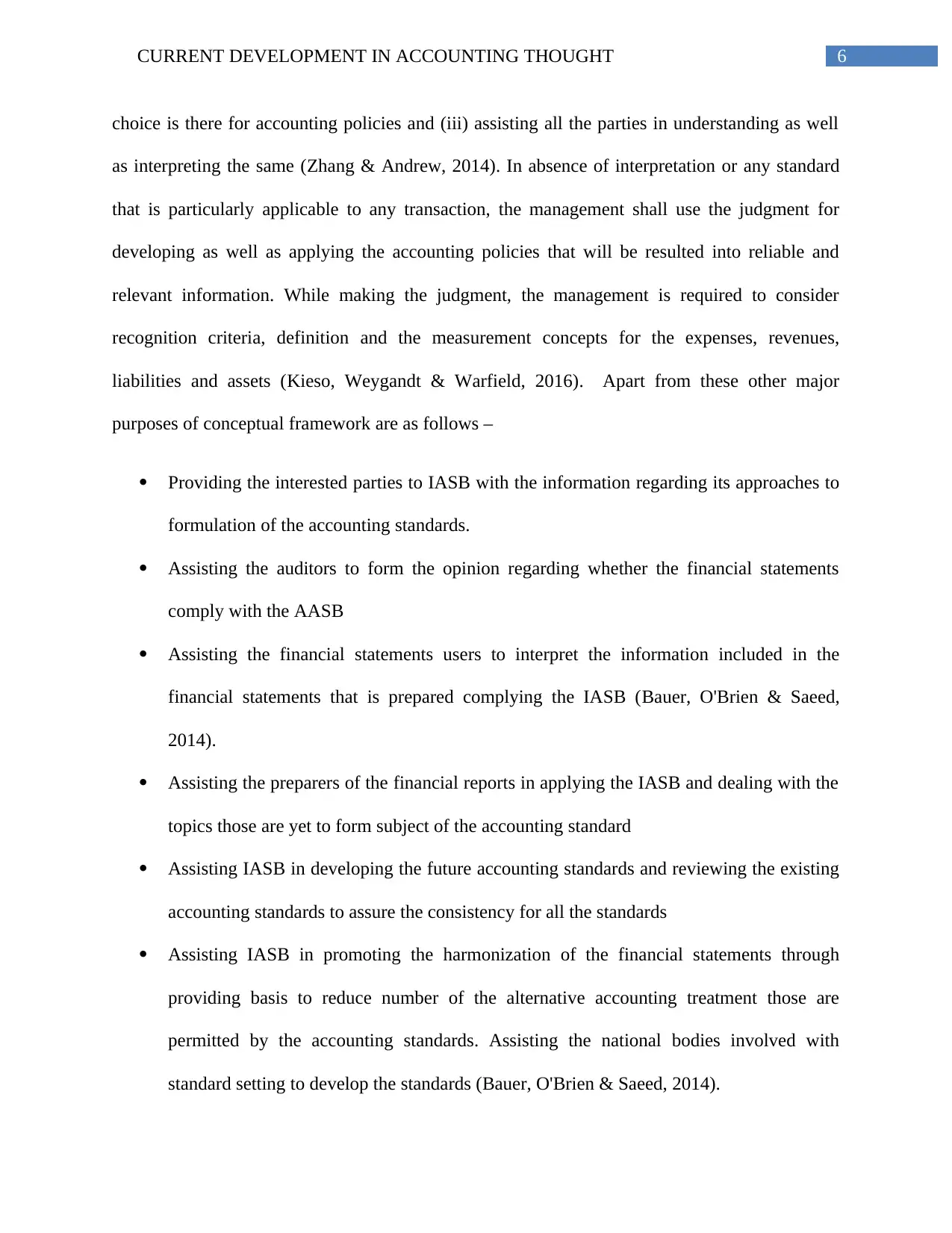
6CURRENT DEVELOPMENT IN ACCOUNTING THOUGHT
choice is there for accounting policies and (iii) assisting all the parties in understanding as well
as interpreting the same (Zhang & Andrew, 2014). In absence of interpretation or any standard
that is particularly applicable to any transaction, the management shall use the judgment for
developing as well as applying the accounting policies that will be resulted into reliable and
relevant information. While making the judgment, the management is required to consider
recognition criteria, definition and the measurement concepts for the expenses, revenues,
liabilities and assets (Kieso, Weygandt & Warfield, 2016). Apart from these other major
purposes of conceptual framework are as follows –
Providing the interested parties to IASB with the information regarding its approaches to
formulation of the accounting standards.
Assisting the auditors to form the opinion regarding whether the financial statements
comply with the AASB
Assisting the financial statements users to interpret the information included in the
financial statements that is prepared complying the IASB (Bauer, O'Brien & Saeed,
2014).
Assisting the preparers of the financial reports in applying the IASB and dealing with the
topics those are yet to form subject of the accounting standard
Assisting IASB in developing the future accounting standards and reviewing the existing
accounting standards to assure the consistency for all the standards
Assisting IASB in promoting the harmonization of the financial statements through
providing basis to reduce number of the alternative accounting treatment those are
permitted by the accounting standards. Assisting the national bodies involved with
standard setting to develop the standards (Bauer, O'Brien & Saeed, 2014).
choice is there for accounting policies and (iii) assisting all the parties in understanding as well
as interpreting the same (Zhang & Andrew, 2014). In absence of interpretation or any standard
that is particularly applicable to any transaction, the management shall use the judgment for
developing as well as applying the accounting policies that will be resulted into reliable and
relevant information. While making the judgment, the management is required to consider
recognition criteria, definition and the measurement concepts for the expenses, revenues,
liabilities and assets (Kieso, Weygandt & Warfield, 2016). Apart from these other major
purposes of conceptual framework are as follows –
Providing the interested parties to IASB with the information regarding its approaches to
formulation of the accounting standards.
Assisting the auditors to form the opinion regarding whether the financial statements
comply with the AASB
Assisting the financial statements users to interpret the information included in the
financial statements that is prepared complying the IASB (Bauer, O'Brien & Saeed,
2014).
Assisting the preparers of the financial reports in applying the IASB and dealing with the
topics those are yet to form subject of the accounting standard
Assisting IASB in developing the future accounting standards and reviewing the existing
accounting standards to assure the consistency for all the standards
Assisting IASB in promoting the harmonization of the financial statements through
providing basis to reduce number of the alternative accounting treatment those are
permitted by the accounting standards. Assisting the national bodies involved with
standard setting to develop the standards (Bauer, O'Brien & Saeed, 2014).
Paraphrase This Document
Need a fresh take? Get an instant paraphrase of this document with our AI Paraphraser
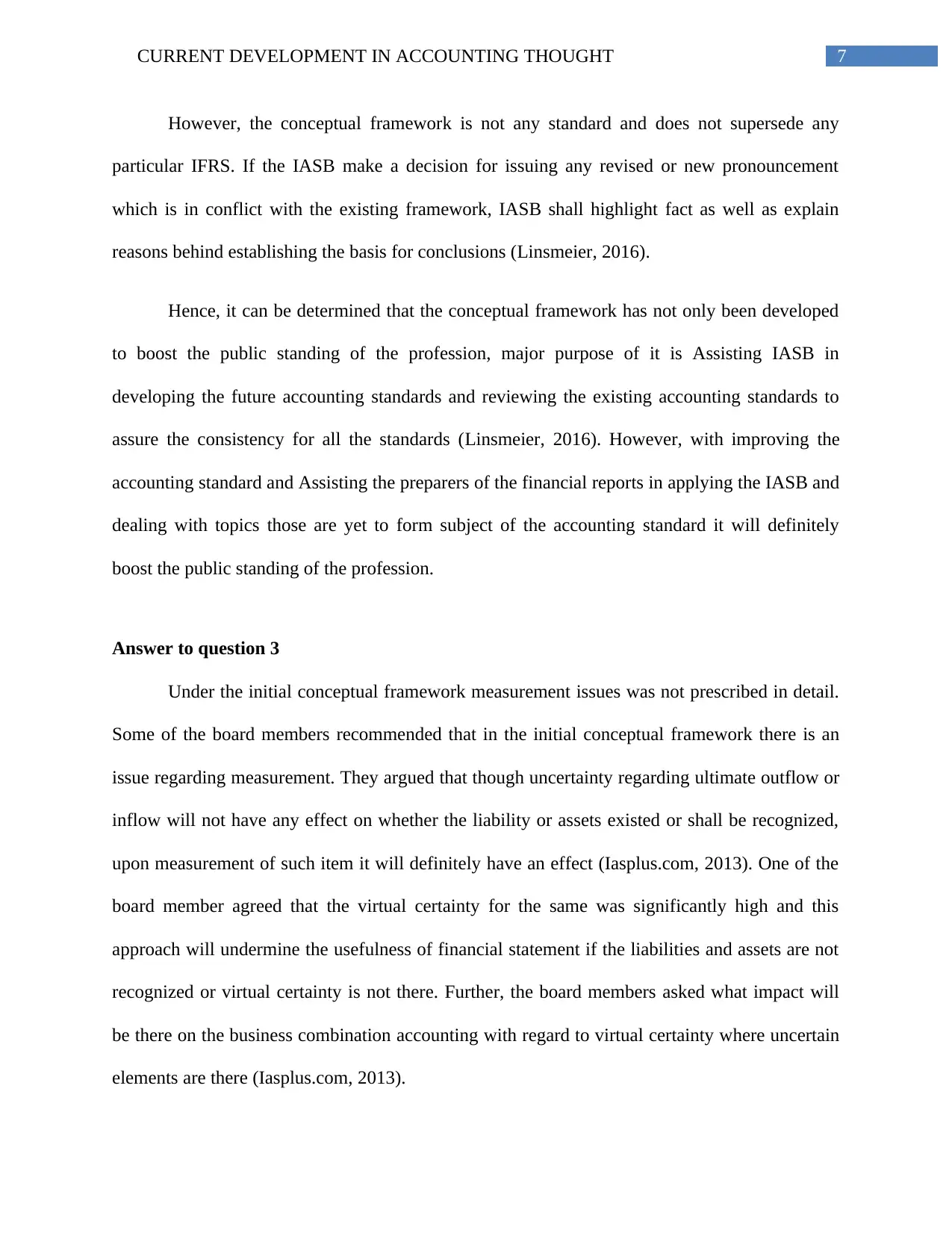
7CURRENT DEVELOPMENT IN ACCOUNTING THOUGHT
However, the conceptual framework is not any standard and does not supersede any
particular IFRS. If the IASB make a decision for issuing any revised or new pronouncement
which is in conflict with the existing framework, IASB shall highlight fact as well as explain
reasons behind establishing the basis for conclusions (Linsmeier, 2016).
Hence, it can be determined that the conceptual framework has not only been developed
to boost the public standing of the profession, major purpose of it is Assisting IASB in
developing the future accounting standards and reviewing the existing accounting standards to
assure the consistency for all the standards (Linsmeier, 2016). However, with improving the
accounting standard and Assisting the preparers of the financial reports in applying the IASB and
dealing with topics those are yet to form subject of the accounting standard it will definitely
boost the public standing of the profession.
Answer to question 3
Under the initial conceptual framework measurement issues was not prescribed in detail.
Some of the board members recommended that in the initial conceptual framework there is an
issue regarding measurement. They argued that though uncertainty regarding ultimate outflow or
inflow will not have any effect on whether the liability or assets existed or shall be recognized,
upon measurement of such item it will definitely have an effect (Iasplus.com, 2013). One of the
board member agreed that the virtual certainty for the same was significantly high and this
approach will undermine the usefulness of financial statement if the liabilities and assets are not
recognized or virtual certainty is not there. Further, the board members asked what impact will
be there on the business combination accounting with regard to virtual certainty where uncertain
elements are there (Iasplus.com, 2013).
However, the conceptual framework is not any standard and does not supersede any
particular IFRS. If the IASB make a decision for issuing any revised or new pronouncement
which is in conflict with the existing framework, IASB shall highlight fact as well as explain
reasons behind establishing the basis for conclusions (Linsmeier, 2016).
Hence, it can be determined that the conceptual framework has not only been developed
to boost the public standing of the profession, major purpose of it is Assisting IASB in
developing the future accounting standards and reviewing the existing accounting standards to
assure the consistency for all the standards (Linsmeier, 2016). However, with improving the
accounting standard and Assisting the preparers of the financial reports in applying the IASB and
dealing with topics those are yet to form subject of the accounting standard it will definitely
boost the public standing of the profession.
Answer to question 3
Under the initial conceptual framework measurement issues was not prescribed in detail.
Some of the board members recommended that in the initial conceptual framework there is an
issue regarding measurement. They argued that though uncertainty regarding ultimate outflow or
inflow will not have any effect on whether the liability or assets existed or shall be recognized,
upon measurement of such item it will definitely have an effect (Iasplus.com, 2013). One of the
board member agreed that the virtual certainty for the same was significantly high and this
approach will undermine the usefulness of financial statement if the liabilities and assets are not
recognized or virtual certainty is not there. Further, the board members asked what impact will
be there on the business combination accounting with regard to virtual certainty where uncertain
elements are there (Iasplus.com, 2013).

8CURRENT DEVELOPMENT IN ACCOUNTING THOUGHT
Owing to the above issue regarding measurement, staff of the board presented an early
draft for measurement section that shall be included in the discussion paper (DP) of conceptual
framework. It was been noted that another paper was there regarding initial as well as subsequent
measurement. The staffs recognized that the particular section of DP will discuss the principles
to identify the appropriate methods for measurement. The part regarding measurement principle
will state that measurement term is used for describing the procedure for determining the
numbers to be presented or disclosed in financial statement (Iasplus.com, 2013). Further, the
staff noted down that measurement section in DP will be based on the premise that IASB will not
select same measure for all the items included in the financial statements. Further, the staff
mentioned to board that DP will include 3 fundamental principles for measurement that were
accumulated from objectives of the financial reporting and the qualitative characteristics for
useful information associated with finance within chapters 1 and 3 under conceptual framework
as follows –
Principle 1 – main purpose of measurement is representing most relevant information
faithfully regarding claims against entity, economic resources of reporting entity and the
efficiency with which the management as well as governing body have discharged the
responsibilities for using the resources of the entity (Iasplus.com, 2013).
Principle 2 – generally, though the measurement concept starts with any item in the
financial statement, relevance of the information provided by the particular measurement
approach also dependent upon the way in which it affects statement of the
comprehensive income and the statement of cash flows and statement of equity, if
applicable and the notes to financial reports (Iasplus.com, 2013).
Owing to the above issue regarding measurement, staff of the board presented an early
draft for measurement section that shall be included in the discussion paper (DP) of conceptual
framework. It was been noted that another paper was there regarding initial as well as subsequent
measurement. The staffs recognized that the particular section of DP will discuss the principles
to identify the appropriate methods for measurement. The part regarding measurement principle
will state that measurement term is used for describing the procedure for determining the
numbers to be presented or disclosed in financial statement (Iasplus.com, 2013). Further, the
staff noted down that measurement section in DP will be based on the premise that IASB will not
select same measure for all the items included in the financial statements. Further, the staff
mentioned to board that DP will include 3 fundamental principles for measurement that were
accumulated from objectives of the financial reporting and the qualitative characteristics for
useful information associated with finance within chapters 1 and 3 under conceptual framework
as follows –
Principle 1 – main purpose of measurement is representing most relevant information
faithfully regarding claims against entity, economic resources of reporting entity and the
efficiency with which the management as well as governing body have discharged the
responsibilities for using the resources of the entity (Iasplus.com, 2013).
Principle 2 – generally, though the measurement concept starts with any item in the
financial statement, relevance of the information provided by the particular measurement
approach also dependent upon the way in which it affects statement of the
comprehensive income and the statement of cash flows and statement of equity, if
applicable and the notes to financial reports (Iasplus.com, 2013).
⊘ This is a preview!⊘
Do you want full access?
Subscribe today to unlock all pages.

Trusted by 1+ million students worldwide
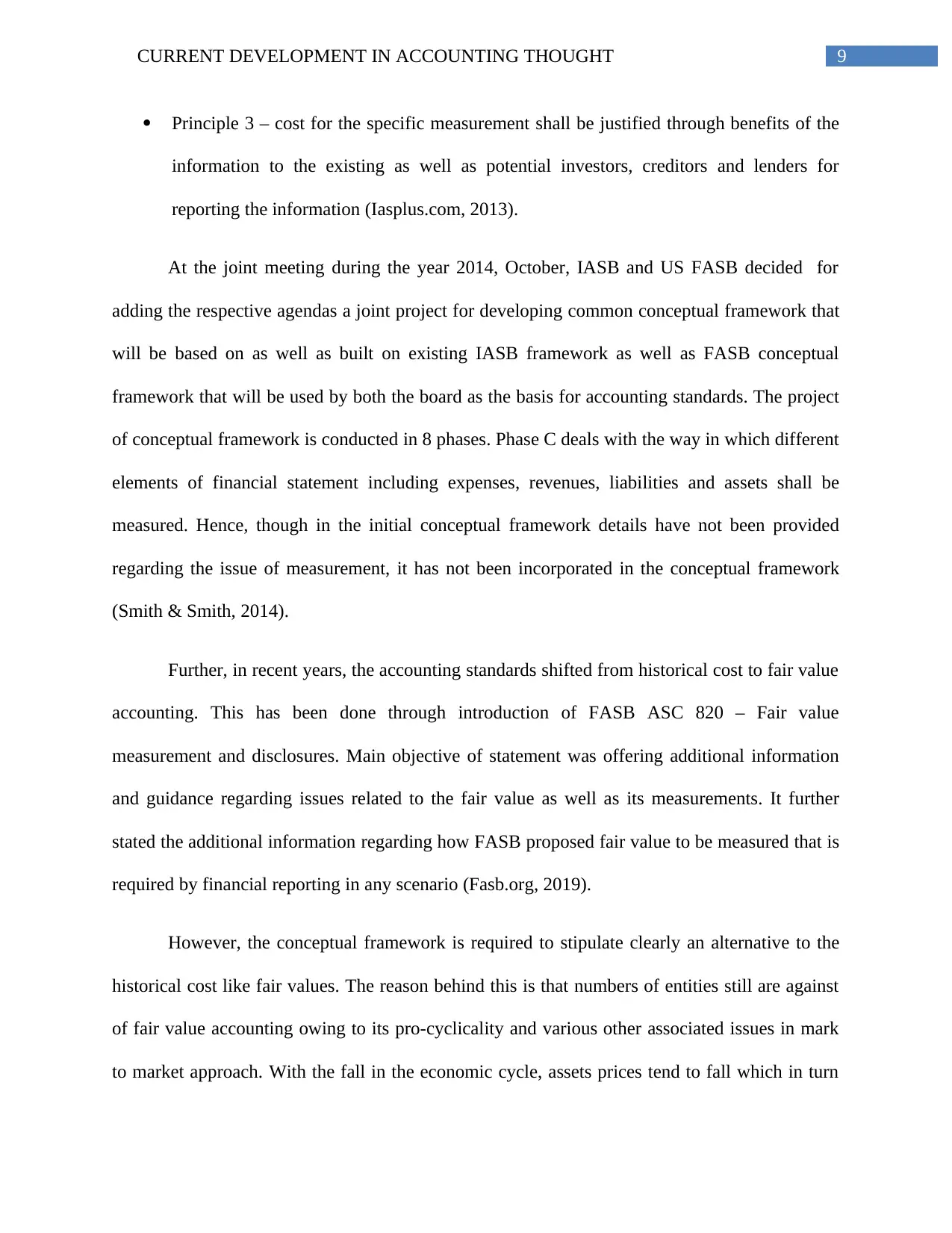
9CURRENT DEVELOPMENT IN ACCOUNTING THOUGHT
Principle 3 – cost for the specific measurement shall be justified through benefits of the
information to the existing as well as potential investors, creditors and lenders for
reporting the information (Iasplus.com, 2013).
At the joint meeting during the year 2014, October, IASB and US FASB decided for
adding the respective agendas a joint project for developing common conceptual framework that
will be based on as well as built on existing IASB framework as well as FASB conceptual
framework that will be used by both the board as the basis for accounting standards. The project
of conceptual framework is conducted in 8 phases. Phase C deals with the way in which different
elements of financial statement including expenses, revenues, liabilities and assets shall be
measured. Hence, though in the initial conceptual framework details have not been provided
regarding the issue of measurement, it has not been incorporated in the conceptual framework
(Smith & Smith, 2014).
Further, in recent years, the accounting standards shifted from historical cost to fair value
accounting. This has been done through introduction of FASB ASC 820 – Fair value
measurement and disclosures. Main objective of statement was offering additional information
and guidance regarding issues related to the fair value as well as its measurements. It further
stated the additional information regarding how FASB proposed fair value to be measured that is
required by financial reporting in any scenario (Fasb.org, 2019).
However, the conceptual framework is required to stipulate clearly an alternative to the
historical cost like fair values. The reason behind this is that numbers of entities still are against
of fair value accounting owing to its pro-cyclicality and various other associated issues in mark
to market approach. With the fall in the economic cycle, assets prices tend to fall which in turn
Principle 3 – cost for the specific measurement shall be justified through benefits of the
information to the existing as well as potential investors, creditors and lenders for
reporting the information (Iasplus.com, 2013).
At the joint meeting during the year 2014, October, IASB and US FASB decided for
adding the respective agendas a joint project for developing common conceptual framework that
will be based on as well as built on existing IASB framework as well as FASB conceptual
framework that will be used by both the board as the basis for accounting standards. The project
of conceptual framework is conducted in 8 phases. Phase C deals with the way in which different
elements of financial statement including expenses, revenues, liabilities and assets shall be
measured. Hence, though in the initial conceptual framework details have not been provided
regarding the issue of measurement, it has not been incorporated in the conceptual framework
(Smith & Smith, 2014).
Further, in recent years, the accounting standards shifted from historical cost to fair value
accounting. This has been done through introduction of FASB ASC 820 – Fair value
measurement and disclosures. Main objective of statement was offering additional information
and guidance regarding issues related to the fair value as well as its measurements. It further
stated the additional information regarding how FASB proposed fair value to be measured that is
required by financial reporting in any scenario (Fasb.org, 2019).
However, the conceptual framework is required to stipulate clearly an alternative to the
historical cost like fair values. The reason behind this is that numbers of entities still are against
of fair value accounting owing to its pro-cyclicality and various other associated issues in mark
to market approach. With the fall in the economic cycle, assets prices tend to fall which in turn
Paraphrase This Document
Need a fresh take? Get an instant paraphrase of this document with our AI Paraphraser
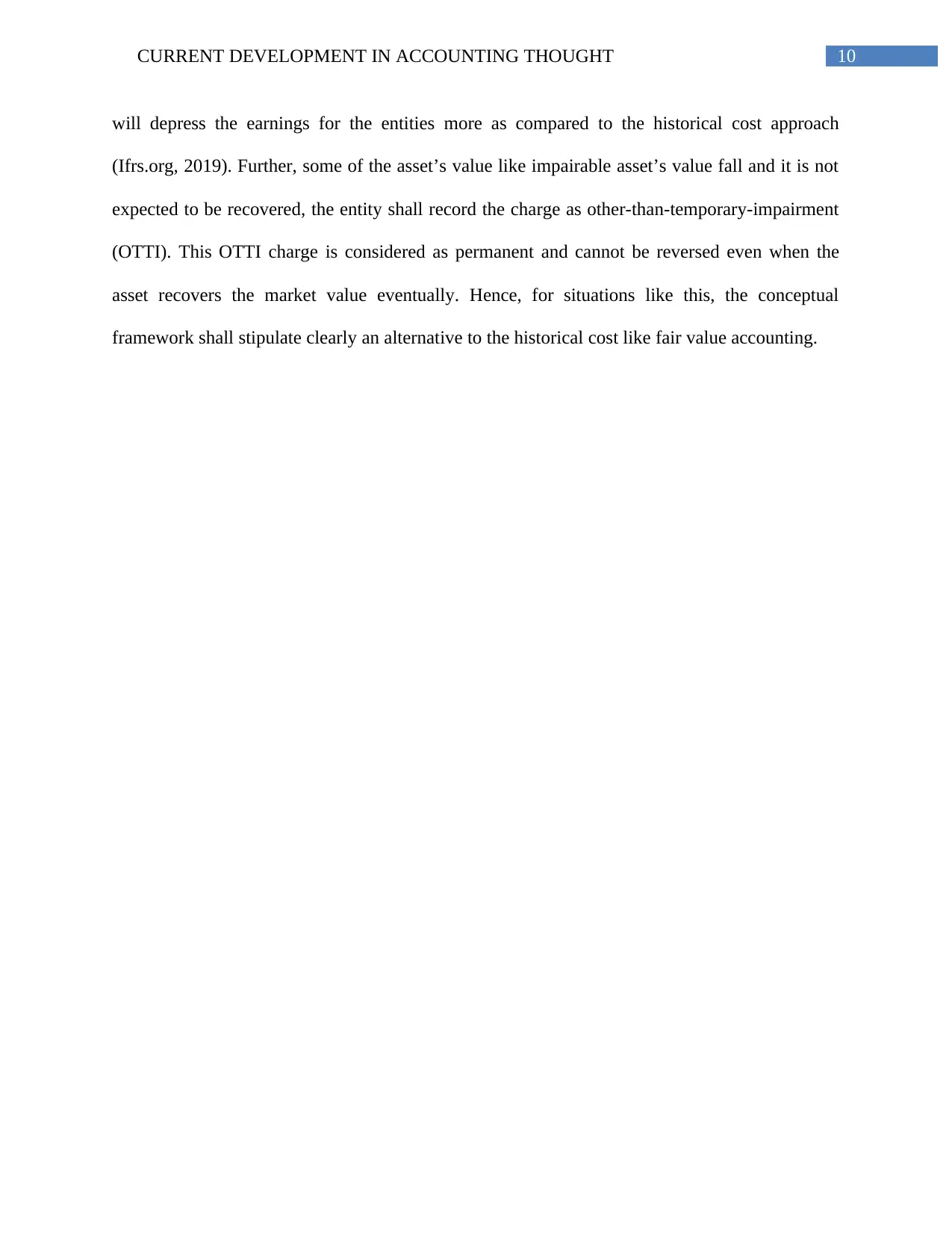
10CURRENT DEVELOPMENT IN ACCOUNTING THOUGHT
will depress the earnings for the entities more as compared to the historical cost approach
(Ifrs.org, 2019). Further, some of the asset’s value like impairable asset’s value fall and it is not
expected to be recovered, the entity shall record the charge as other-than-temporary-impairment
(OTTI). This OTTI charge is considered as permanent and cannot be reversed even when the
asset recovers the market value eventually. Hence, for situations like this, the conceptual
framework shall stipulate clearly an alternative to the historical cost like fair value accounting.
will depress the earnings for the entities more as compared to the historical cost approach
(Ifrs.org, 2019). Further, some of the asset’s value like impairable asset’s value fall and it is not
expected to be recovered, the entity shall record the charge as other-than-temporary-impairment
(OTTI). This OTTI charge is considered as permanent and cannot be reversed even when the
asset recovers the market value eventually. Hence, for situations like this, the conceptual
framework shall stipulate clearly an alternative to the historical cost like fair value accounting.
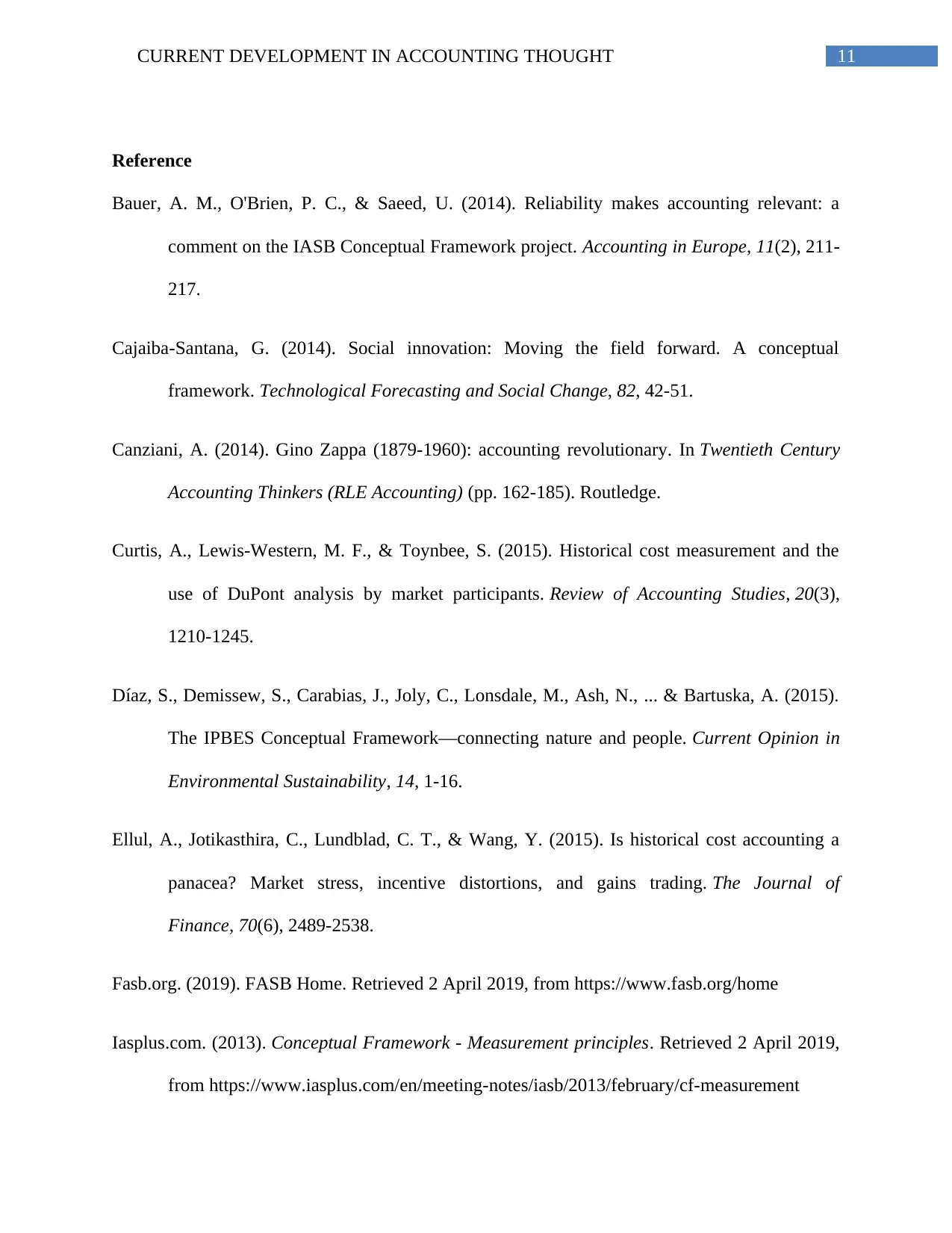
11CURRENT DEVELOPMENT IN ACCOUNTING THOUGHT
Reference
Bauer, A. M., O'Brien, P. C., & Saeed, U. (2014). Reliability makes accounting relevant: a
comment on the IASB Conceptual Framework project. Accounting in Europe, 11(2), 211-
217.
Cajaiba-Santana, G. (2014). Social innovation: Moving the field forward. A conceptual
framework. Technological Forecasting and Social Change, 82, 42-51.
Canziani, A. (2014). Gino Zappa (1879-1960): accounting revolutionary. In Twentieth Century
Accounting Thinkers (RLE Accounting) (pp. 162-185). Routledge.
Curtis, A., Lewis-Western, M. F., & Toynbee, S. (2015). Historical cost measurement and the
use of DuPont analysis by market participants. Review of Accounting Studies, 20(3),
1210-1245.
Díaz, S., Demissew, S., Carabias, J., Joly, C., Lonsdale, M., Ash, N., ... & Bartuska, A. (2015).
The IPBES Conceptual Framework—connecting nature and people. Current Opinion in
Environmental Sustainability, 14, 1-16.
Ellul, A., Jotikasthira, C., Lundblad, C. T., & Wang, Y. (2015). Is historical cost accounting a
panacea? Market stress, incentive distortions, and gains trading. The Journal of
Finance, 70(6), 2489-2538.
Fasb.org. (2019). FASB Home. Retrieved 2 April 2019, from https://www.fasb.org/home
Iasplus.com. (2013). Conceptual Framework - Measurement principles. Retrieved 2 April 2019,
from https://www.iasplus.com/en/meeting-notes/iasb/2013/february/cf-measurement
Reference
Bauer, A. M., O'Brien, P. C., & Saeed, U. (2014). Reliability makes accounting relevant: a
comment on the IASB Conceptual Framework project. Accounting in Europe, 11(2), 211-
217.
Cajaiba-Santana, G. (2014). Social innovation: Moving the field forward. A conceptual
framework. Technological Forecasting and Social Change, 82, 42-51.
Canziani, A. (2014). Gino Zappa (1879-1960): accounting revolutionary. In Twentieth Century
Accounting Thinkers (RLE Accounting) (pp. 162-185). Routledge.
Curtis, A., Lewis-Western, M. F., & Toynbee, S. (2015). Historical cost measurement and the
use of DuPont analysis by market participants. Review of Accounting Studies, 20(3),
1210-1245.
Díaz, S., Demissew, S., Carabias, J., Joly, C., Lonsdale, M., Ash, N., ... & Bartuska, A. (2015).
The IPBES Conceptual Framework—connecting nature and people. Current Opinion in
Environmental Sustainability, 14, 1-16.
Ellul, A., Jotikasthira, C., Lundblad, C. T., & Wang, Y. (2015). Is historical cost accounting a
panacea? Market stress, incentive distortions, and gains trading. The Journal of
Finance, 70(6), 2489-2538.
Fasb.org. (2019). FASB Home. Retrieved 2 April 2019, from https://www.fasb.org/home
Iasplus.com. (2013). Conceptual Framework - Measurement principles. Retrieved 2 April 2019,
from https://www.iasplus.com/en/meeting-notes/iasb/2013/february/cf-measurement
⊘ This is a preview!⊘
Do you want full access?
Subscribe today to unlock all pages.

Trusted by 1+ million students worldwide
1 out of 14
Related Documents
Your All-in-One AI-Powered Toolkit for Academic Success.
+13062052269
info@desklib.com
Available 24*7 on WhatsApp / Email
![[object Object]](/_next/static/media/star-bottom.7253800d.svg)
Unlock your academic potential
Copyright © 2020–2025 A2Z Services. All Rights Reserved. Developed and managed by ZUCOL.





